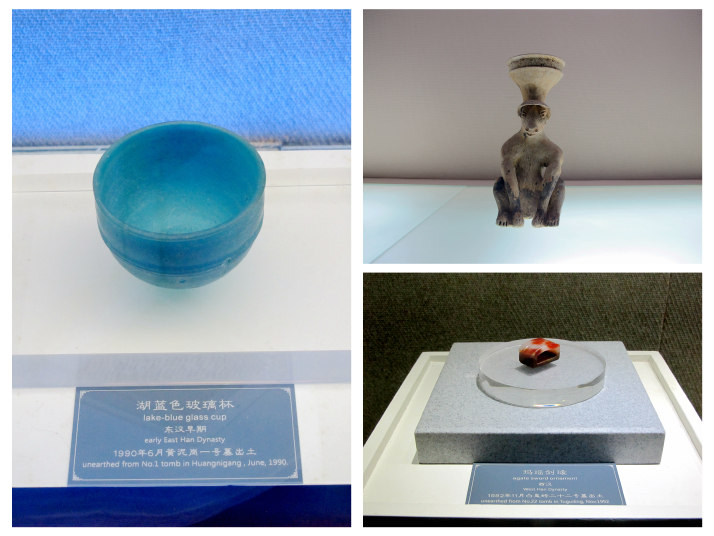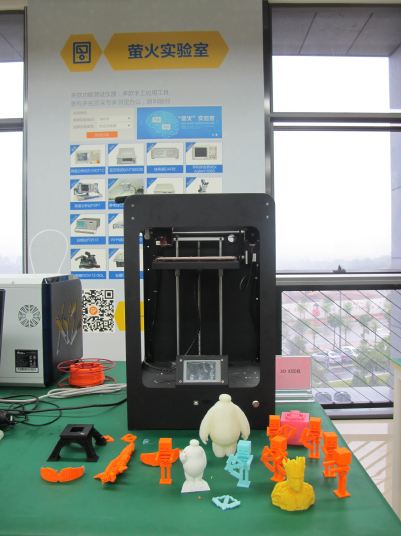| Lifestyle |
| City of Charm | |
| A port city along the ancient maritime silk road develops in the new era | |
|
|
 Cultural relics preserved at the Han-Cultural Museum of Hepu County, Beihai, south China's Guangxi Zhuang Autonomous Region (LU YAN)
A Roman glass bowl, an Indian crystal necklace, green glazed pottery made in Parthia—modern-day Iran—all serve as proof of Beihai's importance as a port city on the ancient maritime silk road. Dating back 2,000 years, the trade route connected China with other countries in East Asia, Southeast Asia, the Middle East, Africa and Europe. At the Han-Cultural Museum of Hepu County in Beihai, south China's Guangxi Zhuang Autonomous Region, a bronze kettle covered with verdigris and decorative design sits in a glass box. Unearthed from a tomb in April 1986, the kettle is identified as a treasure from China's Eastern Han Dynasty (25-220). A museum docent told Beijing Review that there's still liquid inside the kettle which, according to archaeologists, is most likely wine from some 2,000 years ago. Such cultural relics show not only traces of the daily life of ancient China, but also signs of trade and people-to-people exchanges between Beihai and other regions along the ancient maritime silk road. Building on its historical assets and unique features, Beihai has recently been exploring new drivers of development, such as tourism and the electronics and information industry. According to official data, the city's fiscal revenue exceeded 20 billion yuan ($3 billion) last year, up 20.1 percent year on year, ranking first in Guangxi. Beihai Mayor Cai Jinjun said that the city will further improve its business environment and provide quality services for investors and entrepreneurs.  3D-printed statues made by participants during the Second Beihai University Student Innovation Practice Camps from August 21 to September 1 (LU YAN)
Welcoming the world This year, Beihai was selected as a City of Charm for the 15th China-ASEAN Expo (CAEXPO), an event featuring a host of exhibitions, forums and exchange programs that aimed at facilitating China-ASEAN trade and increasing bilateral cooperation. The 2018 CAEXPO was held in Guangxi's capital city of Nanning on September 12-15 with the theme Jointly Building the 21st-Century Maritime Silk Road, Forging the China-ASEAN Community of Innovation. Since the Second CAEXPO in 2005, China and the 10 ASEAN countries have adopted a system whereby each chooses one city or region as a City of Charm to promote the development and business opportunities in that area in terms of trade, investment, culture, tourism and science and technology. Beihai was chosen for several reasons. In 1984, it became one of the first coastal cities in China turning to embrace the world. Since the Belt and Road Initiative was proposed by Chinese President Xi Jinping in 2013, the ancient gateway to Southeast Asia and Africa has focused on enhancing maritime connectivity, international industrial capacity cooperation and cultural exchanges between China and countries along the 21st-Century Maritime Silk Road. Moreover, Beihai boasts rich tourism resources and a scenic landscape. Its tourist attractions, such as Silver Beach, the Mangrove Conservation Area, ocean parks and ancient towns, are magnets for travelers from home and abroad. Vice Mayor Chen Xin said that Beihai will seize the opportunity brought about by the City of Charm designation and actively expand cooperation with ASEAN countries and beyond, so as to achieve sound development. During the 15th CAEXPO, Beihai launched a series of activities involving trade and investment promotion, cultural and sports exchanges, and a seafood festival. In September, 17 projects were signed for the further development of Beihai's tourism. With gross investment reaching 134 billion yuan ($20 billion), the projects cover resort hotel construction, airline services and health management, among others. Cai said at a signing ceremony on September 11 that these projects meet the requirements of the city's tourism upgrading and have great significance in extending the tourism industrial chain and remedying current limitations. "We are accelerating our steps in transforming Beihai into a famous international coastal resort," Cai said. Upgrading industries The electronics and information industry has been a key pillar for Beihai's economic development. For example, the first laptop, the first LCD television and the first computer power unit in Guangxi were all manufactured in Beihai. In 2006, the city established Guangxi's first regional-level electronic industrial base, with the Guangxi Beihai Industrial Park as the mainstay. Last year, the output value of Beihai's electronics and information industry exceeded 130 billion yuan ($19 billion), representing a 13.5-percent growth over the previous year and accounting for over half of the output value of the industry in Guangxi. Currently there are around 300 electronic and information technology companies in the city, employing over 40,000 people. According to Cai, nearly 100 products from these companies are sold on the domestic market and in many other regions around the world including Japan, ASEAN countries, the Americas and Europe. "Many well-known Chinese international electronics brands manufacture their products here. If you look carefully at your laptop label, there's a great possibility that it says 'Made in Beihai,'" said Wang Gang, Deputy Director of the Management Committee of the Guangxi Beihai Industrial Park. He told Beijing Review that the park is applying for inclusion in the list of national-level development zones. To further boost the development of the electronics and information industry, Beihai has introduced a number of policies to attract companies to invest or stay in the city, including tax reductions and exemptions, preferential access to land utilization and subsidies. The industry is also moving toward a smarter and high-end direction, with leading companies the driving force in this transformation. For instance, PC monitor manufacturer HKC headquartered in Shenzhen, Guangdong Province, plans to increase input in research and development on mobile intelligent terminals at its Beihai manufacturing base. "Convenient transportation, preferential policies and a favorable location are some of the reasons that make us want to devote more energy to Beihai," said Lu Huijuan, head of the HKC Management Department. Besides the power of companies, industrial upgrading cannot be successful without innovation and creativity from the younger generation. Since 2017, the Beihai Science and Technology Bureau, the Guangxi Beihai Industrial Park and other relevant parties have begun jointly organizing training camps for young people to cultivate their passion for electronic and information technology. This year, over 100 college students, mostly from the Guilin University of Electronic Technology and Guangxi University, were selected to participate in 12 days of activities. They were divided into two teams and worked together to make their own electronic and technological devices including smart car models and 3D-printed statues with the help of professors and experts. Management courses and enterprise tours were also organized for the participants, enabling them to gain a better understanding of how the electronics and information industry functions, thus preparing them to play a major role in the city's further development. Copyedited by Rebeca Toledo Comments to luyan@bjreview.com |
|
||||||||||||||||||||||||||||
|
